
The Khmer Empire, officially the Angkor Empire, the predecessor state to modern Cambodia, was a Hindu-Buddhist empire in Southeast Asia. The empire, which grew out of the former kingdoms of Funan and Chenla, at times ruled over and/or vassalised most of mainland Southeast Asia and parts of Southern China, stretching from the tip of the Indochinese Peninsula northward to modern Yunnan province, China, and from Vietnam westward to Myanmar.
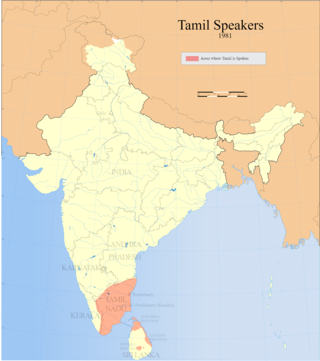
The Tamil people, also known as Tamilar, Thamizhar or simply Tamils, are speakers of the Tamil language and trace their ancestry to the Indian state of Tamil Nadu or Sri Lanka. Tamils constitute 5.9% of the population in India, 15% in Sri Lanka, 6% in Mauritius, 7% in Malaysia and 5% in Singapore. Tamils, with a population of around 76 million and with a documented history stretching back over 2,000 years, are one of the largest and oldest extant ethnolinguistic groups in the modern world.

Srivijaya was a Buddhist thalassocratic Indonesian empire based on the island of Sumatra, Indonesia, which influenced much of Southeast Asia. Srivijaya was an important centre for the expansion of Buddhism from the 8th to the 12th century AD. Srivijaya was the first unified kingdom to dominate much of the Indonesian archipelago. The rise of the Srivijayan Empire was parallel to the end of the Malay sea-faring period. Due to its location, this once-powerful state developed complex technology utilizing maritime resources. In addition, its economy became progressively reliant on the booming trade in the region, thus transforming it into a prestige goods-based economy.

The Shailendra dynasty was the name of a notable Indianised dynasty that emerged in 8th-century Java, whose reign signified a cultural renaissance in the region. The Shailendras were active promoters of Mahayana Buddhism with the glimpses of Hinduism, and covered the Kedu Plain of Central Java with Buddhist monuments, one of which is the colossal stupa of Borobudur, now a UNESCO World Heritage Site.
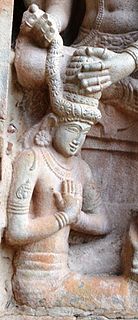
Rajendra Chola I or Rajendra I was a Tamil Chola emperor of South India who succeeded his father Rajaraja Chola I to the throne in 1014 CE. During his reign, he extended the influence of the Chola empire to the banks of the river Ganga in North India and across the Indian ocean to the West and South East Asia, making the Chola Empire one of the most powerful maritime empires of India. Rajendra's conquests included Sri Lanka, Maldives, and he successfully invaded the territories of Srivijaya in Malay Peninsula, Southern Thailand, Sumatra and Java in South East Asia. The Cholas exacted tribute from Thailand and the Khmer kingdom of Cambodia. He defeated Mahipala, the Pala king of Gauda in present-day Bengal and Bihar, and to commemorate his victory he assumed the title of 'Gangaikondachola', literally the Chola who conquered the Ganga and also built a new capital city called Gangaikonda Cholapuram.

Suryavarman I was king of the Khmer Empire from 1006 to 1050. Suryavarman usurped King Udayadityavarman I, defeating his armies in approximately 1002. After a protracted war with Udayadityavarman's would-be successor, Jayavarman V, Suryavarman I claimed the throne in 1010. Suryavarman was a Mahayana Buddhist who was also tolerant of the growing Theravada Buddhist presence in the Khmer kingdom.
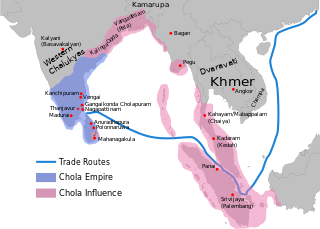
The Chola dynasty was a Tamil dynasty of southern India, one of the longest-ruling dynasties in the world's history. The earliest datable references to the Chola are in inscriptions from the 3rd century BCE left by Ashoka, of the Maurya Empire. As one of the Three Crowned Kings of Tamilakam, along with the Chera and Pandya, the dynasty continued to govern over varying territory until the 13th century CE. Despite these ancient origins, the period when it is appropriate to speak of a "Chola Empire" only begins with the medieval Cholas in the mid-9th century CE.
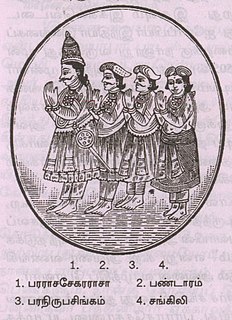
The Arya Chakravarti dynasty were kings of the Jaffna Kingdom in Sri Lanka. The earliest Sri Lankan sources, between 1277 and 1283, mention a military leader of this name as a minister in the services of the Pandyan Empire; he raided the western Sri Lankan coast and took the politically significant relic of the Buddha’s tooth from the Sinhalese capital city of Yapahuwa. Political and military leaders of the same family name left a number of inscriptions in the modern-day Tamil Nadu state, with dates ranging from 1272 to 1305, during the late Pandyan Empire. According to contemporary native literature, such as Cekaracecekaramalai, the family also claimed lineage from the Tamil Brahmins of the prominent Hindu pilgrimage temple of Rameswaram in the modern Ramanathapuram District of India. They ruled the Jaffna kingdom from the 13th until the 17th century, when the last of the dynasty, Cankili II, was ousted by the Portuguese.
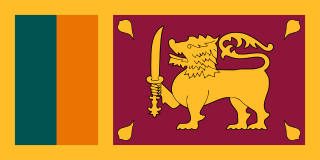
The Kingdom of Polonnaruwa was the Sri Lankan kingdom from which Sinhalese kings ruled the island from the 11th century until 1310 CE. Pollonnaruwa was the second administrative center of Rajarata.
Vikramabahu was a medieval king of Sri Lanka. Following the death of his father in 1029, Vikramabahu led the resistance movement against the Chola invaders of the country, ruling from the southern principality of Ruhuna. He spent a number of years building up his forces to drive out the Chola, but died before he could launch his military campaign.

Dharmasraya is the capital and also the name of the 11th century Malay Hindu kingdom based on the Batanghari river system in modern-day West Sumatra and Jambi, on the island of Sumatra, Indonesia. The kingdom itself could be identified by the name of its capital Dharmasraya or by the name Bhumi Malayu or Suvarnnabhumi according to Padang Roco inscription. The reference to the name Malayu signify that the kingdom is located on previously older Malayu kingdom area prior being absorbed into Srivijayan mandala c. late 7th century, thus suggesting that Dharmasraya was the successor of Malayu. Dharmasraya became an independent kingdom after the downfall of Srivijaya in 1025.

The Chola Navy comprised the naval forces of the Chola Empire along with several other naval-arms of the country. The Chola navy played a vital role in the expansion of the Chola Empire, including the conquest of the Ceylon islands and naval raids on Sri Vijaya.

The Anuradhapura Kingdom, named for its capital city, was the first established kingdom in ancient Sri Lanka and Sinhalese people. Founded by King Pandukabhaya in 377 BC, the kingdom's authority extended throughout the country, although several independent areas emerged from time to time, which grew more numerous towards the end of the kingdom. Nonetheless, the king of Anuradhapura was seen as the supreme ruler of the country throughout the Anuradhapura period. Buddhism played a strong role in the Anuradhapura period, influencing its culture, laws, and methods of governance. Society and culture were revolutionized when the faith was introduced during the reign of King Devanampiya Tissa; this cultural change was further strengthened by the arrival of the Tooth Relic of the Buddha in Sri Lanka and the patronage extended by her rulers.
Mahinda VI (?–1187) was a king of the Kingdom of Polonnaruwa who came to the throne by killing his predecessor Vijayabahu II. He only reigned for five days, being killed by his successor and Vijayabahu II's sub-king, Nissanka Malla.
Inscriptions and historical sources assert that the Medieval Chola king Rajendra Chola I sent a naval expedition to Indochina, the Malay Peninsula and Indonesia in 1025 in order to subdue Srivijaya. The Thiruvalangadu plates, the Leyden grant, and the Tamil stele of Rajendra Chola I are the principal sources of information about the campaign.
Sangrama Vijayatunggavarman was an emperor of Srivijaya of Sailendra dynasty, who reigned in the early 11th century in Kadaram. He was renowned for, during his reign, the great raids of the Chola empire against Srivijaya.

In 1025, Rajendra Chola I or Raja Ranganathan, the Chola king from Tamil Nadu in South India, launched naval raids on the city-state of Srivijaya in maritime Southeast Asia, and conquered Kadaram from Srivijaya and occupied it for some time. Rajendra's overseas expedition against Srivijaya was a unique event in India's history and its otherwise peaceful relations with the states of Southeast Asia. Several places in present day Malaysia and Indonesia were invaded by Rajendra Chola I of the Chola dynasty. The Chola invasion furthered the expansion of Tamil merchant associations such as the Manigramam, Ayyavole and Ainnurruvar into Southeast Asia. The Chola invasion led to the fall of the Sailendra Dynasty of Srivijaya and the Chola invasion also coincides with return voyage of the great Buddhist scholar Atiśa from Sumatra to India and Tibet in 1025. The expedition of Rajendra Chola I is mentioned in the corrupted form as Raja Chulan in the medieval Malay chronicle Sejarah Melaya, and Malay princes have names ending with Cholan or Chulan, such as Raja Chulan of Perak.
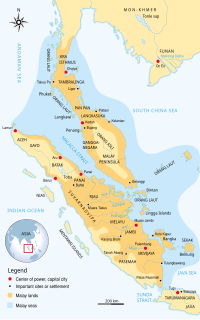
Pannai, Panai or Pane was a Buddhist kingdom located on the east coast of Northern Sumatra that existed between the 11th and 14th centuries. The kingdom was located on the Barumun River and Panai River valleys, in today's Labuhan Batu and South Tapanuli regencies. Because surviving inscriptions and historical records of this period are scarce, the kingdom is among the least known political entities in Indonesian history. Historians suggest that Pannai was probably a principality or a vassal allied under the Srivijayan mandala and later to Dharmasraya kingdom.
The Coastline of Tamil Nadu is located on the southeast coast of Indian Peninsula, and forms a part of Coromandel Coast of Bay of Bengal and Indian Ocean. It is 1,076 km (669 mi) long and is the second-longest coastline in the country after Gujarat. Chennai, the capital of the state and an important commercial and industrial center in the country is located in the northern part of the coast with Kanniyakumari, forming the southern tip where Indian Ocean, Bay of Bengal and Arabian Sea meet. It also shares maritime border with Sri Lanka across the Palk strait in Gulf of Mannar. The coastal corridor consists of 13 districts with 15 major ports and harbors, sandy beaches, lakes and river estuaries. Tamil Nadu is the only state in India with territory on the both the eastern and western coastlines.
Haji Sumatrabhumi was a king of Srivijaya Kingdom who sent envoys to the Chinese Song dynasty in 1017. His name is recorded in Li Tao's Xu Zizhi Tongjian Changbian as Xiachi Suwuzhapumi. The title "Haji" was generally a denomination for a vassal king.












